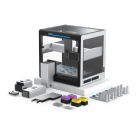Using Python packages in Python API protocols
To use most Python packages in a protocol, they will need to be manually installed on your OT-2. If you’re writing protocols in our Python API, and you want to take advantage of the full power of Python, you might want to import… Read More








